Civil Aviation, India/ 1
(→Personnel Issues) |
|||
| Line 525: | Line 525: | ||
A 27-year-old crew member of an international airline has been booked for allegedly stealing silver jewellery worth over Rs 70,000 from a store at Mumbai airport's Terminal 2 in December and January. The store discovered the thefts in the second week of February.In the wake of the FIR, the woman secured interim anticipatory bail from a sessions court on the condition that she would honour police summons during their investigation. TNN | A 27-year-old crew member of an international airline has been booked for allegedly stealing silver jewellery worth over Rs 70,000 from a store at Mumbai airport's Terminal 2 in December and January. The store discovered the thefts in the second week of February.In the wake of the FIR, the woman secured interim anticipatory bail from a sessions court on the condition that she would honour police summons during their investigation. TNN | ||
| − | |||
| − | |||
| − | |||
| − | |||
| − | |||
| − | |||
| − | |||
=VT code= | =VT code= | ||
| Line 544: | Line 537: | ||
=See also= | =See also= | ||
[[Civil Aviation, India/ 1]] | [[Civil Aviation, India/ 1]] | ||
| + | |||
| + | [[Airports: India]] | ||
[[Civil Aviation, India/ 2: ministry data]] | [[Civil Aviation, India/ 2: ministry data]] | ||
| + | |||
| + | [[Hijacking of aircraft: India]] | ||
Revision as of 07:36, 16 June 2017
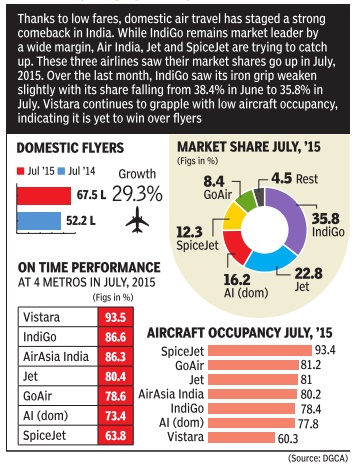
This is a collection of articles archived for the excellence of their content. |
Accidents
See graphic.
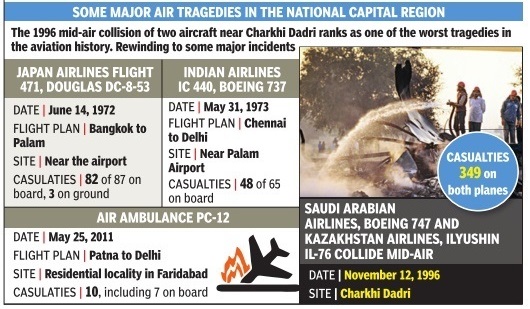

The Times of India
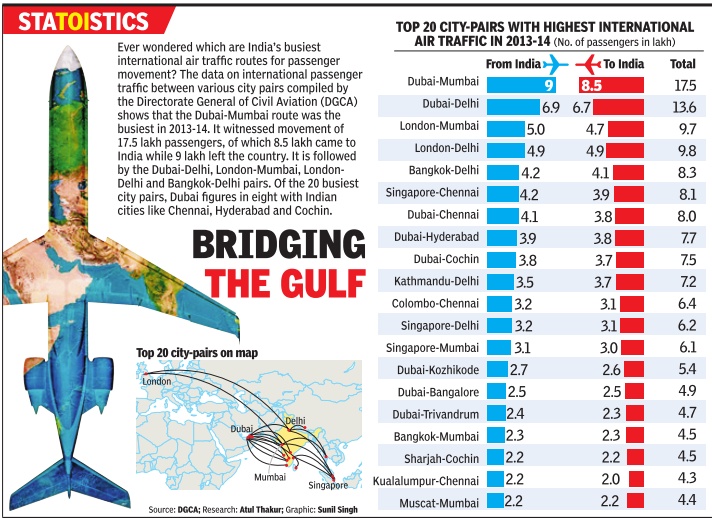
Acquisition, purchase of aircraft
June 2016: Importing older planes
The Hindu, June 27, 2016
Airlines can now import older planes
Domestic airlines can now import aircraft that are up to 18 years old into the country with the government amending more than two-decade rules in this regard.
The move is expected to provide a fillip for the government’s ambitious efforts to boost regional air connectivity as it gives more leeway for operators in expanding their fleet.
Till now, aircraft that are more than 15 years old were not allowed to be imported.
Doing business
As part of larger efforts to improve the ease of doing business in the domestic aviation sector, which has huge growth potential, the Directorate General of Civil Aviation (DGCA) has made changes to rules that had come into effect way back in July 1993.
With the revised norms, pressurised aircraft that are not over 18 years old or those which have not completed 50 per cent of design economic pressurisation cycle can be imported.
A pressurised aircraft is one which is equipped to handle cabin pressure at an altitude of above 10,000 feet.
Such planes should not have completed “15 years of age or 75 per cent of design economic life or 45,000 pressurisation cycle.”
The regulations would be applicable for entities having scheduled, non-scheduled and general aviation operations.
“Considering that modern commercial air transport jet aircraft are significant economic assets that can have an effective economic useful life of decades, the restriction imposed on import of aged aircraft is cautiously revised,” the latest CAR signed by DGCA chief M Sathiyavathy said.
Civil Aviation Requirements: CAR
In this regard, changes have been made in the relevant norms or Civil Aviation Requirements (CAR) effective from June 17.
“Aircraft intended to be imported for air cargo operations shall not have completed 25 years in age or 75 per cent of its design economic cycles or 45,000 landing cycles,” it noted.
The regulator also said that studies were conducted by international aviation community on the correlation between fatal accidents and age of the aircraft.
“Such studies have not clearly established that there is a correlation between accident rate and aircraft age up till 18 years,” it added.
Unpressurised aircraft
With respect to unpressurised aircraft, the decision would be taken on a case to case basis after examining the record of the plane that is to be procured from overseas.
“However, DGCA would normally not allow such aircraft which are more than 20 years old,” it said.
The watchdog noted that aircraft intended to be imported and used for scheduled commercial operations should have their design economic calendar and operational life clearly established by the holder of type certificate, among other requirements. Aircraft manufacturers usually prescribe design standards.
Air routes, the busiest
2014
See graphics The Times of India



Feb 09 2015
Saurabh Sinha
Mumbai-Dubai busiest route in 2014
Delhi-Dubai Second With 13.6L Flyers
The Mumbai-Dubai sector was the busiest international city pair for travel to and from India last year.With as many as 17.5 lakh people flying between these two cities, closely followed by 13.6 lakh between Delhi and Dubai, the Emirate emerged as the destination most frequented by Indians . Dubai saw a whopping 84.5 lakh people flying to and from India last year, way ahead of the second spot of almost 44 lakh occupied by the rest of UAE -of which it too is a part. London, Bangkok, Singapore and Kathmandu were the other major destinations or transit points for Indian globetrotters last year.
India is an important market for all airlines as interna tional travel has been constantly growing in the past few years. Forget metros, even small towns are generating huge volumes of traffic.For instance, 4.5 lakh people flew between Sharjah and Kochi last year. Thiruvananthapuram and Dubai saw 4.7 lakh people flying between them last year. Pune, Varanasi and Amritsar also saw substantial numbers flying to overseas destinations.
While domestic air travel has seen its share of ups and downs in the past seven years, international air travel has been growing at almost 10%. The next round of growth is expected from small towns. The aviation ministry is allowing new airlines to take shape and is focussing on promoting regional connectivity . It is also planning to make it easier for new airlines to fly abroad.
With these moves, it hopes to counter the dominance of foreign, especially Gulf, carriers.
Dubai's dominance comes from the fact that its airline, Emirates, rules Indian skies and is the third largest carrier in India in terms of international market share.
All Indian carriers that fly abroad -Jet Airways, Air India, IndiGo and SpiceJet -also fly to Dubai. While they offer only point-to-point connectivity between India and Dubai, Emirates offers connectivity to rest of the world for Indian flyers from its hub, making it a virtual Pied Piper for Indian travellers. “Star Alliance accepted Air India into its fold mainly to counter the onslaught of Gulf carriers. Emirates is already known as the de facto national airline of India. Abu Dhabibased Etihad's tie-up with Jet Airways means that Jet will feed that hub from 23 cities in India. Together, Gulf carriers pose the biggest challenge not only for Indian carriers but also other airlines that fly into India,“ said an airline official.
With Jet going the Gulf way , Indian aviation has pinned its hopes on AI weaning away long-haul traffic from them with its new-found Star Alliance membership and the joint venture between Tatas and Singapore Airlines, Vistara.
“IndiGo, SpiceJet and GoAir, when it starts flying abroad, will go only to nearby international destinations.Vistara has the capability to quickly mount long haul flights if the rule for Indian carriers to fly abroad is relaxed,“ said an airline official.
Air shows: Bangalore
1911

The headline reads Chaar aaney mein hawai jahaz ka nazaara (Four annas [Re.0.25] to see an aeroplane) / Akhbar Daily Post kay ehtemaam aur intezaam say (Organised by the newspaper Daily Post)
Chethan Kumar | TNN | Bengaluru had its first date with air show a century ago, Feb 20, 2017
Bengaluru had its first date with an air show in 1911.
In 1911, Jules Wyck and Belgian adventurer Baron Pierre De Caters were the two pilots who brought their aircraft to Bengaluru
BENGALURU: As the curtains were drawn on the 11th edition of Aero India on Saturday, thousands who thronged the Yelahanka Air Force Station need to know that they are not the first patrons of such a show. In fact, they are not even the first generation.
Bengaluru, India's aviation capital, had its first date with an air show 106 years ago. February 3, 1911. Cricket hadn't become the religion it is today in India. The Chinnaswamy Stadium was a barren land, and parts of Bengaluru were still a functional cantonment.
While people from districts neighbouring Bengaluru had made their way back then to catch what the organizers had called a "miracle in the skies," Bengaluru's quest for the flying machines remained intact in 2017 with at least three lakh people reported to have visited the aero show.
In 1911, Jules Wyck and Belgian adventurer Baron Pierre De Caters were the two pilots who brought their aircraft to Bengaluru, for a show that garnered a huge response. "But police had been prepared to handle the crowd here, after things had gotten slightly out of hand in Kolkata," historian Vemagal Somashekar said.
If the elaborate preparations of the organizers a century ago are any indication then it only shows that a lacklustre event, like the 2017 edition of Aero India — just 53 aircraft on display and four aerobatic display teams — may fail to garner similar response in the coming years.
The fact that organizers did not reveal the right number of aircraft at Aero India 2017 is an indication that even they know it. When TOI enquired about the details of the show and the preparations in the run-up to the show, Mayaskar Deo Singh, director, Defence Exhibition Organisation, the nodal government agency organizing the show said: "An official release with final numbers on participation and other details will be issued so that there is no confusion."
The official release days before the show had claimed that the number of aircraft participating would be 72, as many as the 2015 show, rated much better, had seen. Answering a specific question, defence minister Manohar Parrikar, however, had said on February 14: "There are 53 aircraft participating..."
Also, there are ways to watch the show for free, hundreds of citizens who stood with their cameras on terraces, the highway, some even got hospitality at villages around the air base.
But organizers in 1911 had figured out a plan for such free viewers. A poster in Urdu, issued by merchants and businessmen from the Baidwadi (present day Shiva jinagar) area, reveals that the organizers, who had learnt that people would not buy tickets as they thought planes could be spotted even otherwise, had organized the show in such a way that only those with tickets (worth 25 paise each) had a one-hour exclusive.
"...Between 3.30pm and 4.30pm the planes will fly at a height of just 30 metre which only the ticket holders can see. For a few minutes after 4.30pm, the planes will fly a little higher," reads a translation of the poster documented by the state archives department.
Mustafa Khan (mandi merchants, Ibrahim Sahib Street); Abdul Razak (businessman, Modi Road); Ibrahim Sahib (Meenakshi Kovil Street), Abdul Razak Sahib (steel merchant, Narayan Pillai Street) and Mastan Khan from Baidwadi (present day Shiva jinagar) were the men who had signed off on the poster —they are an indication of how Bengaluru had a good trade set-up.
While TOI got a look at the poster, permission to take a photograph was denied. The poster, which has been sourced from fly.historicwings.com, further reveals as Somashekar had pointed out.
Police had been ordered to patrol major roads leading to the venue such as South Parade Road (now MG Road), Brigade Road and Church Street and even in Cubbon Park.
Alcohol on domestic flights
Banned in the 1990s
Saurabh Sinha, No wine on flight, courtesy unruly flyer, Mar 29, 2017: The Times of India
In the wake of the violent MP issue, everyone abhors unruly passengers now for being a big risk to flight safety , co-passengers and crew members.This dislike will go up several notches when you realise that you are denied a harmless glass of wine or beer on domestic flights thanks to one such disruptive flyer.
The government had way back in early 1990s suspended the flying licence of Damania Airways for about 10 days after two passengers got into a brawl (one of them got inebriated) after being served liquor on a MumbaiGoa flight, said an industry old-timer. Following this episode, the government banned serving of alcoholic drinks on domestic flights.
Parvez Damania, the promoter of Damania Airways which flew from 1993 to 1997, says grounding of his airline for a drunken brawl was “politically motivated“ and it took help from several quarters to get it revoked. Damania was among the first airlines in India to serve liquor on domestic flights. After Damania, Vijay Mallya made a strong pitch for allowing at least beer on domestic flights when Kingfisher started flying in 2005. But by then the fear of people getting drunk on `short' domestic flights had gripped the authorities which continues even now and the permission has not been given again.
“A Delhi-Kochi flight is as long as Delhi-Dubai and Delhi-Port Blair nonstop is longer. But one can have beer while flying to Dubai but not on same duration or longer flights in India. This is thanks to a disruptive passenger's act almost 24 years back,“ said the industry old-timer.
Annual growth/ decline in traffic

2014/ No. of fliers rises 10%
Jan 20 2015
Give low fares and Indians will fly like never before. The constant flash sales by SpiceJet last year, which forced other carriers to follow suit, has led to a record 6.7 crore people flying within India in 2014. In December, 64.4 lakh flyers took off within the country, possibly the highest ever number of people flew in a month.
But SpiceJet, which started the fare war, saw itself running out of cash by November, which led to aircraft leasors repossessing many of its Boeing 737 aircraft. Since November, the airline saw its market share fall. In December 2014, its market share was 10.4%, down from 20.4% in July . The low cost carrier is now headed for a change of ownership with co-founder Ajay Singh back in the cockpit.
2014: No. of passengers
The Times of India, Sep 06 2015
As air travel becomes easier and cheaper, more and more travellers are choosing to fly. Flight departure data collected by the World Bank shows that the US recorded over 95 lakh flights leaving from its airports in 2014, followed by China with 33 lakh. In comparison, India clocked only 7.2 lakh
August 2015: domestic fliers
The Times of India, Sep 23 2015
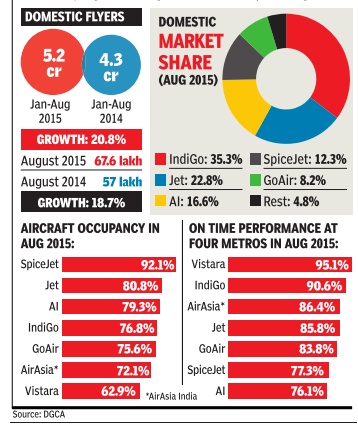
Low fares have made Indian skies a crowded place once again.Deep-discount carrier SpiceJet has been enjoying maximum aircraft occupancy for five months in a row, while full service Vistara is yet to catch flyers fancy. With low-cost carriers ruling the skies, the time has come for budget terminals in India -without sky-high user charges -to meet next phase of growth
2015: India, fastest growing air travel market
The Times of India, Oct 02 2015

India fastest growing air travel mkt globally: IATA
Thanks to low fares and increase in capacity with launch of new airlines, India is now witnessing the highest growth in domestic air traffic globally.
The International Air Transport Association (IATA) said India's domestic passenger traffic demand grew the fastest among seven major aviation markets of the world -Australia, Brazil, China, Japan, Russian Federation and the US.
“India's domestic demand surged 18.3% in August (2015) compared to a year ago, largely reflecting increases in service frequencies and economic strength,“ IATA said. India's growth was followed by China at 13.6% and the Russian Federation at 10.9%.
India's domestic traffic ro se 28% in July , 16.3% in June; 18.2% in May , 20.7% in April and 17.9% in March 2015. August's 18.3% growth, though lower than the growth registered in July, was the fastest globally for that month. India's domestic capacity in the month under review rose 8.4% compa red to August 2014.
“August figures show continuation of the trend of strong demand for air travel, despite some softening in global economic growth, particularly in emerging markets,“ said Tony Tyler, IATA's DG and CEO.
2015: 20% rise in domestic air travel
[[File: 2015, domestic flights in India, number of flyers, airlines’ market share, load factor and on-time performance.jpg|2015: Domestic flights in India: number of flyers, airlines’ market share, load factor and on-time performance; Graphic courtesy: The Times of India, January 19, 2016
20% jump in domestic air travel in 2015
Domestic air travel rose by 20.3% in 2015 over the previous year, registering one of the highest growth rates in the past decade. A record 8.1 crore domestic flyers took to the skies last year, with December logging the highest-ever monthly traffic of over 77 lakh. Low oil prices, which led to airlines offering cheap air fares, lured travellers back. To top low fares, airlines added capacity and frequencies.
Mid-2015- Feb 2017: fastest growing domestic market
Indian air mkt grows fastest for 22 months, March 8, 2017: The Times of India
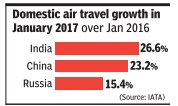
India has been the world's fastest growing domestic air market for 22 months in a row, the International Air Transport Association (IATA) said on Tuesday.This means in last 22 months, India has seen the highest growth in domestic air travel over the same month in previous year. “India led all domestic markets in year-to-year growth for the 22nd month in a row. (Globally) Domestic air travel climbed 9.9% in January year-on-year. All markets except Brazil showed growth, paced by double-digit increases in China, India and Russia,“ IATA said.
2016: 25% rise in domestic air travel
Record 10cr flew within India in 2016, Jan 18, 2017: The Times of India

Cheap air fares in 2016, except during peak travel seasons, thanks to low oil prices and stiff competition, led to a record number of almost 10 crore people flying within the country , up nearly 25% from the previous high of 8.1 crore in 2015.
The post demonetisation period of November 9 to December 31 alone saw over 1.5 crore domestic flyers. Low oil prices made India the world's fastest growing aviation market, with domestic traffic growing at over 20% constantly.
2016: International travel, a rise of 10.4%
Saurabh Sinha, Notebandi fails to impact int'l travel, Feb 22, 2017: The Times of India

It's official now.Demonetisation, announced by PM Narendra Modi on November 8, did not have any impact on international trips to and from India in the October-December, 2016, quarter.
These three winter months -which happen to be the peak inbound months for travel to India -saw the maximum international travel in all the four quarters last year. Thanks to a robust inflow of 71.7 lakh international flyers, the overall foreign travel (arrivals plus departures) in the October-December quarter, 2016, was 1.38 crore -up 10.4% from 1.25 crore in the same quarter previous year (2015).
“People who had to travel, travelled. The numbers show that there were no cancella tions due to the November 8 announcement,“ said Manoj Chacko, CEO business travel at SOTC. Karan Anand of travel major Cox & Kings also said that people did not change their travel planes due to de monetisation. “It (banning of old notes of Rs 500 and Rs 1,000) has not impacted the big organised travel industry players.We have constantly seen buoyancy in outbound travel quarter over quarter,“ Anand said. India saw 5.3 crore international travellers in 2016, up 10.4% from 4.8 crore recorded in the previous year. TOI had on January 25 estimated international travel to be at 5.2 crore last year. Domestic air travel had grown 23.2% in 2016 over 2015 with almost 10 crore people taking to the skies last year.Demonetisation has so far neither impacted domestic, nor international flying.
2016 saw the JetEtihad combine carrying over a crore passengers in and out of India, with the Air India-AI Express combine behind at 88 lakh. Emirates remained the single largest foreign airline with a traffic of 54.6 lakh. It is desperately seeking more flying rights to India.
The growth in international travel came as low oil prices helped airlines, both international and domestic, to offer low fares that led to Indians travelling overseas like never before. Travel portal Yatra COO Sharat Dhall had recently told TOI: “International airfares in 2016 were significantly lower than those in the previous year and airlines offered amazing deals. Apart from this, visitors had access to budget and shared accommodation. As a result, we saw a significant jump in international bookings last year.“
March 2017 vs. March 2016
The Times of India, April 21, 2017
See graphic.
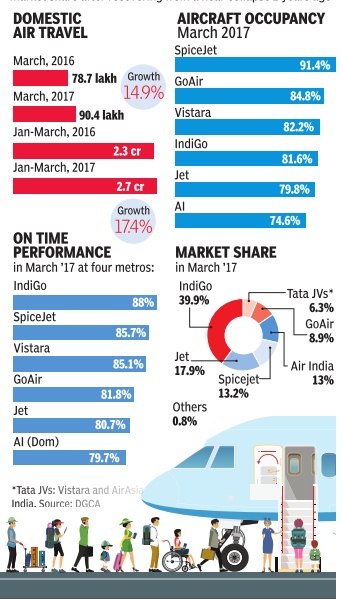
The 20% plus growth in domestic air travel has taken a break in the lean travel month of March. The month saw IndiGo return to the top of on-time-performance charts after several quarters.SpiceJet pipped Air India to become the third largest airline in market share after recovering from a near collapse in 2015.
2017: India world’s no.3/ domestic; no.4/ international
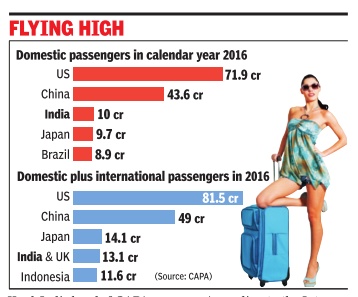
Equals UK In Domestic & Int'l Flyer Nos
Propelled by the tail wind generated by increasing domestic air travel demand, the Indian aviation industry continues to soar to new heights. The world's fastestgrowing air travel market for several months in a row has added another feather on its cap by being the third-largest domestic aviation market globally with more people flying within the country last year than Japan, which has been pushed to number four spot.
Calendar year 2016 saw 10 crore domestic flyers in India, more than the 9.7 crore in Japan, according to the Centre for Asia Pacific Aviation (CAPA). “In 2015, India was at number four in domestic air travel and now it is at number three. Japan was number three in 2015,“ said Kapil Kaul, India head of CAPA.
“On the internationalcum-domestic air travel front, India saw a combined traffic similar to the UK in 2016 and they are both at number four spot now. UK was ahead of India on this front in 2015. Given the way our air traffic is growing, India is all set to overtake UK this year,“ said Kaul. This data emerges from a report CAPA has prepared for the aviation ministry . According to the International Air Transport Association (IATA), India has overtaken Japan on domestic air travel front as the country has been the world's fastest growing in-country market for 22 months in a row .
This growth, however, has left Indian airports at least the big ones choking. While slots for new flights at metro airports like Delhi and Mumbai are very hard to get, hover ing of flights is a regular occurance again due to air traffic congestion. Given the massive growth, Indian carriers have ordered hundreds of planes but no one knows where they will even be parked.
The government has said it will add aviation infrastructure. Navi Mumbai may get the hugely-delayed airport in a few years and Delhi could also expect another airport in NCR soon with a BJP government both at the Centre and in Lucknow.
“Our expectation is that we would have at least two to three greenfield (new) airports in UP. We are already working with the state government to determine where they would come. There is tremendous interest in a new greenfield airport in western UP and we will like to expedite it with the state government. The greenfield airport in western UP will definitely serve two purposes enable world class air connectivity in the area and add more flight connectivity options for the NCR,“ aviation minister Jayant Sinha said.
Boarding denied
2016: 15,000 passengers denied boarding
Manju V, 15,000 denied boarding by desi carriers in 2016, Apr 15 2017: The Times of India
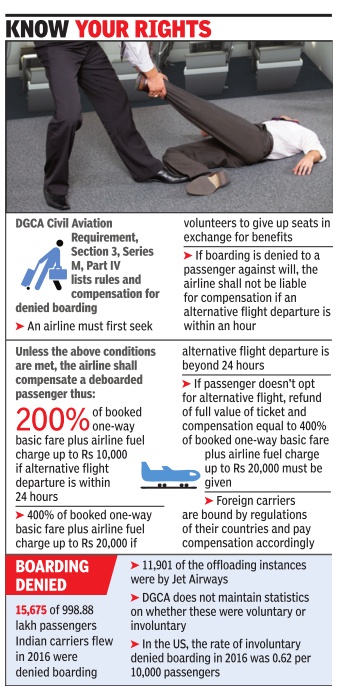
While Indian carriers have never done a United Airlines on passengers they have had to offload, about 15,000 passengers were denied boarding last year, and three of four of such flyers were booked on Jet Airways.
In India, the ratio of passengers offloaded each year is way below the global average.Last year, the ten carriers in the Indian airline industry flew 9.98 crore passengers. Of this, 15,675 were denied boarding or offloaded by carriers, according to the Directorate General of Civil Aviation (DGCA). Jet Airways's figure was 11,901 passengers (out of 1.89 crore it flew in 2016). Between December 2016 and February this year, out of 8,150 flyers offloaded by Indian carriers, 7,266 were Jet Airways passengers. A distant second was Air India (808).
Low cost airline IndiGo, which flew the highest number of passengers (3.9 crore), offloaded only 23 in 2016. That is largely because unlike Air India, Jet Airways and Vistara, which are on the Global Distribution System (a ticketing system that allows overbooking), the system used by IndiGo doesn't permit it to oversell. Compared to the global industry average, Indian carriers have pretty low rates of offloading. According to data from the Department of Transportation, US, 40,629 passengers were denied boarding involuntarily on domestic US flights in 2016. Southwest Airlines had the maximum number of such cases (14,979).
In India, the DGCA does not maintain separate data on whether passengers were voluntarily or involuntarily offloaded. Its norms state that an airline should first seek volunteers and compensate them (see graphic). If boarding is denied to passengers against their will, they should be compensated.
Apart from providing ho tel accommodation (wherever applicable) and booking the passenger on another flight, Indian carriers paid a total of Rs 6.35 crore in compensation for denied boarding last year. Jet Airways alone paid Rs 4.75 crore.
So if you are booked to fly Jet, it would be prudent to do a web or mobile checkin before you reach the airport, print the boarding pass, and most importantly , reach the airline check-in counter early .
Compensation
Compensation for delays, accidents
Mar 19 2015
Flyers set for higher payoffs from airlines
Accidents, delays to cost carriers more
The Narendra Modi government has enhanced the compensation that airlines must pay passengers in case of lost baggage or suffering an injury while travelling with them. If a person dies or suffers bodily injury in an air crash or some other aviation-related accident, the compensation payabale to the family is now Rs 90 lakh, up from Rs 75 lakh earlier.
In case of inordinate flight delays, the compensation could now be as high as Rs 3.5 lakh, up from Rs 3 lakh earlier. The maximum compensation for lost baggage has now been upped to about Rs 84,000 from Rs 74,000 earlier.
The enhanced compensa tion comes with the Cabinet on Tuesday amending the Air Carriage Act that deals with issues like damages to be paid for flight delays, loss of baggage and accidental death. Indian carriers will now pay as their international counterparts, in line with the 1999 Montreal Convention that governs airline liability and compensation.
These compensations are based on something called special drawing rights (SDR), with each SDR worth $1.2.
In India, SDRs are converted into Indian rupees depending on the exchange rate at the time of payment. Damage in case of death or bodily injury for each person has been upped from a lakh SDR to 1,13,100 SDR. The liability in case of destruction, loss or delay of cargo has been raised from 17 SDR (Rs 1,265) to 19 SDR (Rs 1,400).
The change came as International Civil Aviation Organisation (ICAO) calculated that inflation had risen by over 10% -the trigger for a recalculation. In India, the change came with the Cabinet clearing an amendment to the Carriage by Air Act by inserting a new provision enabling the government to revise the limits of liability as and when the revised limits are notified by the ICAO. India had signed the Montreal Convention in May 2009. Also, the Convention stipulates that the compensation figures must be revised every five years.
Defence airspaces
2015: Shortening routes over defence airspace
The Times of India, Jul 27 2015

Ayyappan V
Flight time shortens as defence airspace opens
Airlines save on fuel and time by avoiding detours
A Kolkata-bound flight taking off from Hyderabad first flies eastward to reach the coast and then takes a northerly route with more deviations to reach its destination. The route has been designed to avoid military installations at Begumpet near Hyderabad and at Barrackpore near Kolkata. But with the restricted military airspace being opened up for civilian flights last month, pilots can now take a direct northerly path.
Airports Authority of India (AAI) has started implementing flexible use of airspace which allows civilian aircraft to fly over military installations. This allows airliners to save fuel and time besides avoiding unnecessary detours. In June, the Kolkata-Hyderabad route was opened and this saves almost 15 minutes of flying time. As this been successful, AAI is planning to allow flights to use military airspace on the Delhi-Goa route on weekends and on the Nagpur-Pune route on Sundays very soon. Military airspace, used for training and sorties, is marked as restricted areas on aviation charts . Civil airliners have to avoid such paths even when air force or navy planes are not flying. After much deliberation , defence ministry has decided to relax rules.
The proposal was made many years ago and was approved in 2013. Implementation has picked up momentum now. AAI has begun training air traffic controllers and staff, and has drawn up a manual to conduct route-specific trials between cities where detours are lengthier. The first was conducted between Kolkata and Jaipur.
An airline official said, “There was a training programme in Delhi in June. Another meeting was held in Hyderabad last week. The concept will improve safety as there will be less number of restrictions for pilots and air traffic controller.“
Chennai, though, has not been considered as of now since it is located at the farthest corner and does not fall between flight routes connecting major cities. The aim now is to eliminate detours of cross-country flights.
But Chennai would benefit if detours a flight takes before nearing the city airport come into focus. Flight paths over the city will be decongested if routes to the airport are designed to bypass the airspace used by Tambaram air force station and Arakkonam naval station. Flexible use of airspace will be beneficial for Benguluru and Chennai which are surrounded by military installations.
An AAI official said civil-military aviation cooperation is also being carried out as per the direction of International Civil Aviation Organisation which says that “shared use of airspace by civil and military aviation shall be arranged to ensure safety, regularity and efficiency of international civil aviation as well as the requirements of military air traffic.”
Delayed flights
Budget airlines to offer food: SC
Dhananjay Mahapatra TNN
The Times of India, July 9, 2011
New Delhi: Low-cost airlines cannot hide behind the “no free meal” clause printed on tickets to refuse food to passengers if the flight gets delayed by three hours. In an important judgment, the Supreme Court ruled that the exclusion clause not to provide meals would apply only to passengers who had not boarded the flight and were free to purchase food at the airport.
“It will not apply to passengers who are on board and a delay in the flight taking off denies them access to food and water,” said a bench of Justices R V Raveendran and A K Patnaik, while absolving IndiGo of any wrongdoing in a case of alleged ill-treatment of passengers on a fog-delayed flight in 2007.
“In the extraordinary situation where passengers are physically under the complete care and control of the airline, as it happens when they have boarded the aircraft and have no freedom to alight, the duty of the airline to protect and care for them-...would prevail over any term of contract excluding any facilitation, except when the carrier itself cannot access food due to emergency situation,” the bench said. “No public utility service can say it is not bound to care for the health, welfare and safety of the passengers because it is a low cost carrier,” said Justice Raveendran, who authored the judgment.
Three-hour delay will entitle flyers to food, says SC
Low-cost airlines must provide meals to passengers, who have already boarded, in case there is a delay in the flight taking off, said a Supreme Court bench of Justices R V Raveendran and A K Patnaik while absolving IndiGo of any wrongdoing in a case of alleged ill-treatment of passengers on a fog-delayed flight in 2007.
Government Policies
2016: New Aviation Policy
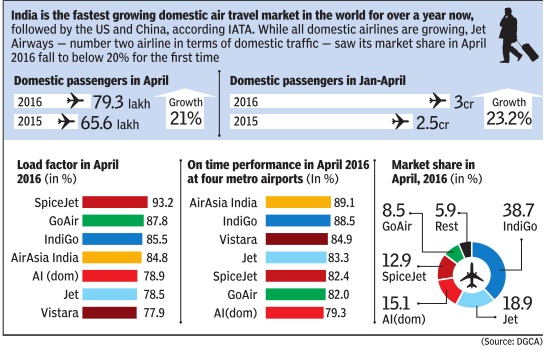
The Times of India, Jun 16 2016
Aviation policy puts small towns on the map for flyers
One may soon be able to fly to Bikaner or Bathinda, with the government aiming to put small towns on the aviation map and capping fares at Rs 2,500 an hour for locations that have so far been untouched by air connectivity . While there is a ceiling on fares, those flying from metros or large cities will have to pay a “small levy“ to fund building of no-frills airports.The Centre and states will chip in with funds and other concessions.
The plan, which has been in the works for the past few months, is part of the new civil aviation policy that was approved by the Cabinet. Announcing the policy , civil aviation minister Ashok Gajapathi Raju ruled out capping domestic air fares on existing routes, leaving it to market forces.
In addition, a new policy for helicopters, including setting up of four heliports, and allowing choppers to fly under 5,000 feet in unrestricted airspace without ATC clearance has been proposed in the new policy .
India is the fastest grow ing aviation market, clocking 22% rise in domestic traffic; the government hopes to increase the number of flyers to 30 crore by 2022, from eight crore currently. The new aviation policy announced on Wednesday aims to step up the growth rate and boost tourism while making air travel affordable for the aam aadmi.
“Regional connectivity, where the capping of fares has been announced, will benefit flyers greatly. For instance, there are no flights between Bangalore and Mysore simply because there is no passenger load factor. It's a 30 minute flight. If the fare costs Rs 1,200 many would prefer to fly,“ said Sudhakara Reddy, president of consumer group Air Passengers Association of India.
Aviation secretary R N Choubey said distance from airports was one of the key factors deterring people from flying to smaller towns. “NDA govt clears India's first ever integrated National Civil Aviation Policy. This will be a gamechanger for the sector... Regional Connectivity Sche me (RCS) --to revive unserved airports and routes in Tier II III cities,“ Raju tweeted. His deputy, Mahesh Sharma said the government would look to build 5080 no-frills airports across the country, many of them using airstrips that had been abandoned after World War II.
Each such airport is expected to cost between Rs 50 and Rs 100 crore and would come up in states which offer lower VAT on aviation fuel, provide police and fire services free of cost and supply power and water atconcessional rates.
On its part, the Centre will offer lower service tax and bear 80% of the burden to make flying to these destinations financially viable.But the key will be lower state levies on fuel as it accounts for nearly half the fare, Choubey told reporters at press conference.
States levy as much as 25% high value added tax on aviation turbine fuel, pushing up fares.
DIAL can use vacant land commercially: HC
In a boost to the private operator running Delhi's international airport, the high court on Monday cleared the decks for it to utilise vacant airport land for commercial purposes.
A bench of Chief Justice G Rohini and Justice Sangita Rohini and Justice Sangita Dhingra Sehgal set aside a policy decision taken by the Centre to exclude IGI airport from the ambit of its 2016 national civil aviation policy .The policy liberalised the use of non-flying related land strips in an airport for commercial use. “Accordingly, the letter da ted 10.10.2016 of the Respondent No.1 (government) is hereby set aside and there shall be a direction to the respondents to take the necessary further steps in terms of the findings recorded by us in this order and to extend the benefit of liberalised use of airport land under clause 12(d) of NCAP , 2016 to the Petitioner (DIAL) in respect of IGI 0Airport on par with the existing and future airports of AAI as well as future projects under PPP ,“ the bench ruled, granting relief to DIAL. The private operator had approached HC challenging IGI's exclusion from the benefits of new aviation policy on the ground that only future private-public partnership projects are covered under the new scheme.
In its defence, the government maintained that NCAP has been initiated and issued in the national interest, kee ping in mind domestic and international passenger traffic for overall growth of national civil aviation.
But HC pointed out that exclusion of existing PPP airports from availing the benefit of the policy which would enable to develop the existing airports and to increase revenue to the public exchequer, “would be completely arbitrary and discriminatory .“ It added that “exclusion of existing PPP airports is also against the interest of the public at large since while the liberalised use of airport land by the AAI airports and future PPP airports will promote wider economy in the vicinity and benefit the passengers and the public at large in terms of overall development, the economic activity in the vicinity of the existing PPP airports would remain stagnant and deprive the passengers the same benefits.“
The court also reminded the government that DIAL is operating IGI Airport on behalf of AAI, rejecting the Centre's stand that IGI Airport is different from “AAI Airport.“
Laws and rules
The Air Corporation Act, 2016
The Times of IndiaJan 06 2015
The Air Corporation Act of 1953 nationalized the airlines industry in India.The liberalization of the sector started in 1986 when private players were allowed to run air taxis. In 1994, the Air Corporation Act was repealed and private companies were allowed to operate scheduled commercial flights.Airlines registered in India showed an impressive increase of over 600% in passenger volume between 1991 and 2013, when India was ranked 9th in the world in passenger volume. Among the 20 countries registering the highest passenger air traffic, the growth of civil aviation has been even higher over this period in the UAE, Turkey, Ireland and China
The Carriage by Air (Amendment) Bill, 2016
The Times of India, Mar 12 2016

Saurabh Sinha
Bill for higher air mishap damages gets LS approval
Parliament approved a bill providing for enhanced compensation to air travellers in case of death, injury , lost baggage or even inordinate delay in flights, with the Lok Sabha passing it with minor amendments. The Carriage by Air (Amendment) Bill was passed by the Lok Sabha in December 2015 and by Rajya Sabha, with minor amendments, on March 2, 2016. The bill, along with the amendments, came back to the lower House and was adopted by a voice vote. As per provisions of the bill, the compensation for death in an air accident will be calculated on the basis of Special Drawing Rights (SDR).The bill intends to raise the liability limit for damages in case of death or bodily injury for each person from 100,000 SDR to 113,100 SDR. The currency value of the SDR is based on market exchange rates of a basket of major currencies -US dollar, euro, Japanese yen and pound sterling. As per the latest exchange rate, the compensation limit rises to more than Rs 1 crore. One SDR is equivalent to around Rs 93 at present.
The bill also proposes to raise the liability for delay in carriage for each person from 4,150 SDR to 4,694 SDR, while the liability in case of destruction, loss, damage or delay of baggage will be raised from 1,000 SDR to 1,131SDR.
India's aviation security regulator is all set to get more teeth, with the government sanctioning a three-fold increase in the manpower of Bureau of Civil Aviation Security (BCAS) to take it from 190 to 600. “The impact of this move will be that BCAS will have presence at all airports. As of now, we have eight regional offices. This number will go up to 20. The regulatory agency will be reorganised and revamped,“ said an official. The recruitment for the additional posts has begun. But the government will have to make a start by appointing a person to head BCAS. B B Dash, joint commissioner, has been officiating as the commissioner of the agency. But his five-year term gets over in three months..
Photography
“Air side“ photography
Saurabh Sinha DGCA bars clicking pics near aircraft Sep 15 2016 : The Times of India (Delhi)
Flyers will no longer be allowed to take pictures or selfies while boarding or alighting from aircraft. The Directorate General of Civil Aviation has reinforced restrictions on “air side“ photography by passengers in a new rule issued primarily to prohibit pilots from taking selfies in cockpits of airborne planes as the regulator has found the latter to be a major distraction that could affect safety .
A DGCA air safety circular issued on August 29 has asked airlines to ensure that “passengers do not indulge into photography while embarkingdisembarking from aircraft.“ Also, passengers will no longer be able to request crew to let them in the cockpit to click a quick selfie while disembarking. In fact, photography inside cockpit has been banned for crew also in all phases of flight and not just while flying.
No-fly list
2017: rules formulated
Unruly passengers could be barred from flying for life, May 6, 2017: The Times of India
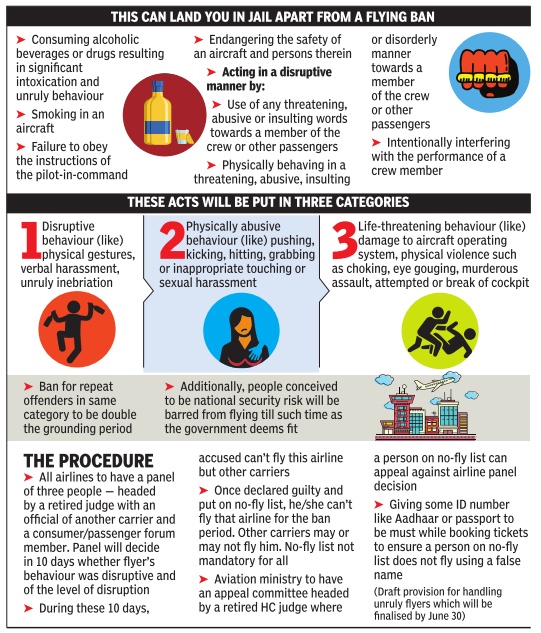
Aggrieved Flyers Will Have Option To Appeal Ban
Unruly behaviour on a flight -or even with airline staff on the ground -from June-end could mean a ban on flying for up to a lifetime. The aviation ministry presented the draft rules for India's first no-fly list (NFL) on Friday which puts disrup tive behaviour on board into three categories and prescribes different grounding periods for each level.
And to ensure that this provision is not misused against innocent passengers who may have been genuinely aggrieved by deficiency of service from an airline, the Centre has provided for appealing against the grounding order. However, Shiv Sena MP Ravindra Gaikwad's act of beating up an Air India staffer on March 23 -which led to the NFL -will not come under the purview of the proposed rules.
These proposals are in a draft civil aviation requirement (CAR) on which public comments can be sent for the next 30 days. After that, the ministry will examine them and it hopes to come out with the final rule before June 30. The first level of disrup tive behaviour includes “physical gestures, verbal harassment and unruly inebriation“. The next has “physically abusive behaviour“ like pushing, kicking and includes “inappropriate touching or sexual harassment“. The highest level is for “life-threatening behaviour, damage to aircraft operating system, physical violence such as choking, eye gouging, murderous assault, attempted or actual breach of “ cockpit.
“A passenger charged un der first level can be grounded for up to three months; up to six months under the second level and for third level, grounding can be upwards of two years with no maximum limit (meaning up to a lifetime). For repeat offenders in the same level, the period of grounding is proposed to be doubled,“ aviation secretary R N Choubey said. Grounding will be in addition to airlines filing police complaints against accused with its own consequences for the unruly flyers. Delhi Police, however, is yet to act on the complaint AI filed against Gaikwad.
All airlines will need to have a panel headed by a retired districts and sessions judge with a senior official of another airline and a member of consumer or passenger associationforum as members.Airline crews will file complaints of unruly behaviour with this panel which will have to decide on whether the passenger is actually guilty of disruptive behaviour and of which level in 10 days. During these 10 days, the accused flyer will be barred from travelling on that particular airline. The no fly list will be under the Directorate General of Civil Aviation (DGCA) and airlines will have to inform it who all have been placed on the same.
“Once this standing committee of airlines decides the case, the flyer will not travel on any flight, whether domestic or international, of that particular carrier depending on the period of grounding. However, it will not be mandatory for other Indian carriers to follow this list. Other Indian and foreign carriers can also ground a person on NFL for the same period,“ said Choubey .
The aviation ministry will set up an appeals panel -which will be headed by a retired high court judge with a senior airline official and a person from consumerpassenger association as member. A passenger found to be disruptive by an airline panel and grounded can appeal against the decision in this panel. However, he or she shall remain grounded pending the appeal which will also have to be decided within a fixed time frame.
Personnel Issues
Pilots suddenly taking mass leaves
Nov 08 2016 : The Times of India Report sick en masse, face licence cancellation, DGCA warns pilots Saurabh Sinha
The government is planning to clamp down on pilots suddenly taking mass leaves -usually by reporting sick together when facing an issue with their management. The Directorate General of Civil Aviation (DGCA) is proposing to cancel, either temporarily or permanently , licences of crew who resort to mass leaves “in public interest“ as these stirs lead to large scale flight cancellations. A draft civil aviation requirement titled “adherence to flight duty assignment by pilots“ says that airlines must immediately send doctors to homes of pilots when they report sick en masse.
The DGCA action comes after Jet Airways faced this issue earlier this month with its pilots and over a hundred of its flights were affected. The regulator then asked Jet to send a list of “habitual offender“ pilots. Other airlines, notably Air India and erstwhile Indian Airlines, too face this issue.
“It has been observed that pilots at times do not adhere to assigned flight duties that have a bearing on flight safety or public interest. Patterns have been observed wherein pilots rostered for flights report sick especially during times of festivals, weekends or at times during periods of disagreement with the management over issues of work terms and conditions,“ the draft CAR issued by DGCA acting chief B S Bhullar says.
And here's the warning for pilots: “Any act on the part of pilots, wherein they pretend to be sick to escape flight duty or report late to the aircraft. . . would be treated as an act against the public interest and shall attract enforcement action against them as per the provisions of the Aircraft Rules.“
2016: 54% rise in docked crew
Unsafe skies: 54% rise in docked crew, Feb 04 2017: The Times of India
India may be the world's fastest growing aviation market but the country's skies are getting increasingly unsafe as the air traffic grows.
January-December, 2016 saw as many as 427 pilots and cabin crew of Indian carriers facing regulatory action for various safety violations like turning up drunk to fly or for being involved in accidents. This number was 54% higher than the regulatory action taken against 275 cockpit and cabin crew members in 2015. The figure in 2014 was a high 391 due to extra surveillance on private planes used for political campaigning.
“We have started a new system for doing safety checks based on risk assessment that led to this surge in detection of safety violations. Generally , we have heightened surveillance that led to a higher number last year. This included cases of crew flying more than the permitted number of hours,“ said a senior Directorate General of Civil Aviation (DGCA) official.
The regulatory actions are decided by DGCA's safety division that is headed by joint DG Lalit Gupta. Last year's safety drive saw the regulator directing filing FIRs against two pi lots (one each of Air India and Jet) and three cabin crew members (two of AI and one of Jet) who were found tipsy after operating international routes.
“Crew is suspended for reasons like failing BA tests for a maximum of eight weeks as airline crew is a precious resource and cannot be kept on ground for long. They are given corrective training and then fly again,“ said the official.
DGCA wants more punctual airlines
In a bid to clear the air on airline punctuality, the Directorate General of Civil Aviation (DGCA) is likely to recommend full automatisation of on time performance (OTP) recording mechanism at airports. The DGCA is studying the process of recording OTP at Delhi, Mumbai, Bangalore and Hyderabad after getting complaints from a carrier.
Security of flying aircraft
Bay of Bengal flights gets safer
The Times of India Jan 11 2016
Chennai
TIMES NEWS NETWORK
Flying over Chennai airspace has become safer for international flights as air traffic controllers can now track them better over the Bay of Bengal.
In a bid to enhance safety and monitoring of planes better, Airports Authority of India (AAI) has bifurcated the oceanic airspace, spread over 4 lakh square nautical miles till the Andaman and Nicobar Islands, into west and east regions.
The airspace is crucial for global air connectivity because 400 planes cruise along 14 international routes connecting Europe to Australia and the Far East everyday , over an expansive water body where tracking planes is difficult. This traffic is in addition to the domestic traffic from Chennai and Kolkata to Port Blair. Now, two dedicated teams of air traffic controllers will monitor planes flying in their respective regions so that they will not miss any flights in the airspace that is traffic-intense yet difficult to monitor because radar coverage is not efficient over such a vast area.The system will help overcome blind spots where air traffic controllers will not get signals showing movement o planes on their monitors.
Chennai has the largest airspace spread over the ocean where flights are cur rently monitored using voice communication with very high frequency (VHF) and high frequency telephony controller-pilot datalink, sat ellite phones and satellite based automatic dependent surveillance broadcast used as a backup for radar.
“The airspace has been made into two sectors based on traffic density and workload of controllers, traffic density and the number of points where air routes intersect. This will be implemented in three phases on trial and is expected to help airlines fly at their optimum level and save fuel and time,“ said a senior AAI official.
AAI board member for ANS A K Dutta inaugurated the facility on Saturday and said several such system were being implemented to help airlines cut down on fuel, operational cost and emission. AAI also introduced SMode operation to allow air traffic controllers to identify a plane as soon as they see a blip on their screens based on a code set by the crew.
Toilet habits
Long-haul flights delayed, airlines lose money
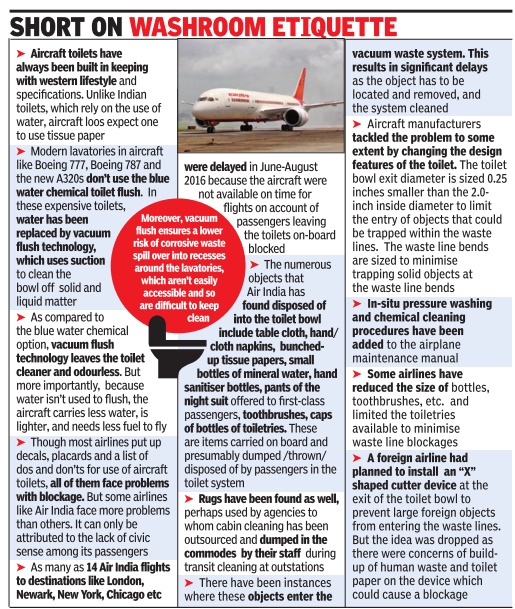
Commodes Clogged Often With Bottles, Cups, Diapers
Mumbai: Claustrophobic though it may be, once the door is shut and locked, an aircraft toilet turns temporarily into a sanctuary where a passenger can escape from the crowd and, often, lose the pretense of manners necessitated by the formality of air travel.
Unfortunately for airlines across the world, what a passenger does behind a closed toilet door can have a direct impact on their earnings. It's the one aspect that airlines have absolutely no control over, but decides whether the aircraft will depart on time for the next flight or, worse, whether it will be grounded for toilet repairs.
“If a passenger throws any object into the toilet, like a plastic bottle, soiled diapers, a bunch of tissue papers, it could damage its vacuum flush system. Then the object has to be located, it has to be removed and the flush system repaired. The next flight is delayed, the losses are multifold,“ said an airline source.
A senior AI cabin crew member said, “The older aircraft used the blue liquid chemical toilet flush system.When there was a blockage, we would pour hot water and then flush after some time and it would often clear the blockage. Now, newer aircraft such as the Boeing 777 and Boeing 787 have a vacuum flush which is advanced technology . But once these toilets are blocked, there is nothing we can do.“ When a toilet cannot be used, a log entry is made by the cabin crew. “On average, there would be 30-60 log entries a month by cabin crew about toilets that have been rendered useless by passengers who dumped bottles, rags or other such items into the commode,“ he added.
It was such “toilet abuse“, as airlines describe such cases, that is suspected to have triggered the headline-grabbing fracas on Saturday's Delhi-Chicago Air India flight.When it departed, only eight out of the 12 toilets were functioning. En route the 17-hour flight, even the eight toilets went out of order. With no toilets to use, the over 340 passengers, including seven infants, had to stay put with bladders full till the flight landed.Whether AI maintained its toilets well remains to be seen.The AI spokesperson was not available for comment. But irrespective of whether the toilets were maintained well, the incident has brought to fore the issue of rampant toilet abuse by passengers, especially Indians, a practice AI has been a victim of for years now.
“In August last year, AI's Newark-Mumbai flight made an unscheduled stop in Istanbul as all the toilets were unserviceable. But it was particularly bad in 2016 between June 5 and August 23, when the toilets left blocked by passengers delayed 14 flights to destinations such as London, Newark, Chicago and New York,“ said an Air India official. These are all long-haul flights going to destinations with passengers that one could assume know how to use a toilet properly . But the reality is quite different. Anyone who has ever flown on an AI international flight would have seen that the toilets work when the flight departs, but as the hours fly by , there will be at least one toilet or two rendered unserviceable because of either unhygienic use or because it has been left blocked by a discarded object.
Lack of civic sense or culture gap?
An AI official said that airlines the world over face problems with clogged toilets, but not to the extent that Indian carriers do. The problem has as much to do with civic behaviour as it does with cultural differences. Aircraft toilets are made to western specifications, with toilet papers, while Indians are habituated to using water to clean up. “Some passengers don't have any concern for other users. They leave the toilet messy with water everywhere and worse, the paper cups and bottles used to fill water are dumped into the commode,“ he added.
Airlines are, meanwhile, doing all they can to curb such practices, carrying out awareness on their use through onboard announcements, demo videos and so on, even as they continue to spend more on repairs and maintenance.
Airhostess booked in Mumbai for theft
A 27-year-old crew member of an international airline has been booked for allegedly stealing silver jewellery worth over Rs 70,000 from a store at Mumbai airport's Terminal 2 in December and January. The store discovered the thefts in the second week of February.In the wake of the FIR, the woman secured interim anticipatory bail from a sessions court on the condition that she would honour police summons during their investigation. TNN
VT code
The Times of India, May 4, 2016
Many may not be aware of the origins of the term “VT“, which is the registration code of Indian aircraft.It is “Viceroy Territory“ and continues [till 2016] to be a legacy of the British Raj.
BJP MP Tarun Vijay demanded in the Rajya Sabha the government change this code.
Taking up the issue during zero hour, Vijay said, “India cannot be a territory of the Viceroy“ adding that the issue was raised in 2006-07 and 2008. But then civil aviation minister of UPA government had said, “It has been decided not to replace existing VT mark as no other code which distinctly identifies with India was available.“ VT code was given by International Civil Aviation Organisation. The BJP MP from Uttarakhand said that countries including Fiji, Nepal and Pakistan have changed their code, but India is still continuing with the VT code.
See also
Civil Aviation, India/ 1
